Carl Gustaf Emil Mannerheim
Baron Carl Gustaf Emil Mannerheim (Swedish pronunciation: [kɑːɭ ˈɡɵ̂sːtav ˈěːmɪl ˈmânːɛrˌhejm] (![]()
The Honorable Marshal of Finland Baron Carl Gustaf Emil Mannerheim | |
|---|---|
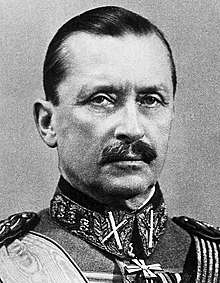 Mannerheim in 1940 | |
| 6th President of Finland | |
| In office 4 August 1944 – 11 March 1946 | |
| Prime Minister | Antti Hackzell Urho Castrén J. K. Paasikivi |
| Preceded by | Risto Ryti |
| Succeeded by | J. K. Paasikivi |
| Commander-in-Chief of the Finnish Defense Forces | |
| In office 17 October 1939 – 12 January 1945 | |
| Preceded by | Hugo Österman (as Commander of the Hosts) |
| Succeeded by | Axel Heinrichs (as Chief of Defence) |
| In office 25 January 1918 – 30 May 1918 | |
| Preceded by | post created |
| Succeeded by | Karl Fredrik Wilkama |
| State Regent of Finland | |
| In office 12 December 1918 – 26 July 1919 | |
| Preceded by | P. E. Svinhufvud |
| Succeeded by | K. J. Ståhlberg as President of the Republic |
| Personal details | |
| Born | 4 June 1867 Askainen, Grand Duchy of Finland, Russian Empire |
| Died | 27 January 1951 (aged 83) Lausanne, Switzerland |
| Resting place | Hietaniemi cemetery, Helsinki |
| Nationality | Finnish |
| Spouse(s) | Anastasie Arapova ( div. 1919) |
| Children |
|
| Parents |
|
| Relatives |
|
| Profession | Military officer, statesman |
| Signature | |
| Military service | |
| Allegiance | |
| Branch/service | Imperial Russian Army White Guard Finnish Army |
| Years of service | 1887–1917 (Russia) 1918–1946 (Finland) |
| Rank | Marshal of Finland |
| Battles/wars | Russo-Japanese War First World War Finnish Civil War Second World War |
Mannerheim made a career in the Imperial Russian Army, rising by 1917 to the rank of lieutenant general. He had a prominent place in the ceremonies for Tsar Nicholas II's coronation in 1896 and later had several private meetings with the Tsar. After the Bolshevik revolution of November 1917 in Russia, Finland declared its independence – but soon became embroiled in civil war between the pro-Bolshevik "Reds" and the "Whites", who were the troops of the Senate of Finland, supported by troops of the German Empire. Mannerheim was appointed the military chief of the Whites. Twenty years later, when Finland was twice at war with the Soviet Union in the period from November 1939 until September 1944, Mannerheim successfully led the defence of Finland as commander-in-chief of the country's armed forces. In 1944, when the prospect of Germany's defeat in World War II became clear, the Finnish Parliament appointed Mannerheim as President of Finland, and he oversaw peace-negotiations with the Soviet Union and the UK. He resigned the presidency in 1946 and died in 1951.
A Finnish survey taken 53 years after his death voted Mannerheim as the greatest Finn of all time.[2] Given the broad recognition in Finland and elsewhere of his unparalleled role in establishing and later preserving Finland's independence from the Soviet Union, Mannerheim has long been referred to as the father of modern Finland,[3][4][5][6][7] and the New York Times has called the Finnish capital Helsinki's Mannerheim Museum memorializing the leader's life and times "the closest thing there is to a [Finnish] national shrine".[5] Mannerheim is the only Finn to have held the rank of field marshal, an honorary rank bestowed upon especially distinguished generals.
Early life and military career
Ancestry
The Mannerheims, originally from Germany, became Swedish noblemen in 1693. In the latter part of the 18th century they moved to Finland, which was then an integral part of Sweden.[8][9] After Sweden lost Finland to the Russian Empire in 1809, Mannerheim's great-grandfather, Count Carl Erik Mannerheim (1759–1837), son of the Commandant Johan Augustin Mannerheim[10][11], became the first head of the executive of the newly-autonomous Grand Duchy of Finland, an office that preceded that of the contemporary Prime Minister. His grandfather, Count Carl Gustaf Mannerheim (1797–1854), was an entomologist and jurist. His father, Carl Robert, Count Mannerheim (1835–1914), was both a playwright and industrialist, with modest success in both endeavors. Mannerheim's mother, Hedvig Charlotta Helena von Julin (1842–1881), was the daughter of a wealthy industrialist. After Mannerheim's father left the family for his mistress in 1880,[12] his mother and her seven children went to live with her aunt Louise, but she died the following year.[13] Mannerheim's maternal uncle, Albert von Julin, then became his legal guardian. The third child of the family, Mannerheim inherited the title of Baron.
Education

He was sent to the Hamina Cadet School, a state school educating aristocrats for the Imperial Russian Army, in 1882.[14] The handsome young Baron towered over his classmates, standing 6 ft 4 in (1.93 m). He was expelled in 1886 when he left without permission.[15] Next he attended the Helsinki Private Lyceum, where he passed the university entrance examinations in June 1887.[16] Besides his Swedish mother tongue, Mannerheim learned to speak Russian, French, German, English and some Finnish.[17] From 1887 to 1889, Mannerheim attended the Nicholas Cavalry School in St. Petersburg.[18] In January 1891, he joined the Chevalier Guard Regiment in St Petersburg.[19]
In 1892, he married a wealthy and beautiful noble lady of Russian-Serbian heritage, Anastasia Arapova (1872–1936).[20][21] They had two daughters, Anastasie "Stasie" (1893–1978) and Sofia "Sophy" (1895–1963).[22] The parents separated in 1902 and divorced in 1919.[23] Mannerheim served in the Imperial Chevalier Guard until 1904. In 1896, he took part in the coronation of Emperor Nicholas II, standing for four hours in his full-dress Imperial Chevalier Guard uniform at bottom of the steps leading up to the imperial throne.[24] Mannerheim always considered the coronation a high-point of his life, recalling with his pride his role in what he called an "indescribably magnificent" coronation.[24] An expert rider, one of his duties was buying horses for the army. In 1903, he was put in charge of the model squadron in the Imperial Chevalier Guard and became a member of the equestrian training board of the cavalry regiments.[25]
Service in the Imperial Russian Army
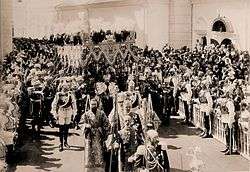
Mannerheim volunteered for active service with the Imperial Russian Army in the Russo-Japanese war in 1904. He was transferred to the 52nd Nezhin Dragoon Regiment in Manchuria, with the rank of Lieutenant-Colonel. During a reconnaissance patrol on the plains of Manchuria, he first saw action in a skirmish and had his horse shot out from under him.[24] He was promoted to Colonel for bravery in the Battle of Mukden in 1905[26] and briefly commanded an irregular unit of Hong Huzi, a local militia, on an exploratory mission into Inner Mongolia.[27]
When Mannerheim returned to St. Petersburg, he was asked to undertake a journey through Turkestan to Beijing as a secret intelligence-officer. The Russian General Staff wanted accurate, on-the-ground intelligence about the reforms and activities by the Qing dynasty, as well as the military feasibility of invading Western China: a possible move in their struggle with Britain for control of inner Asia.[28][29] Disguised as an ethnographic collector, he joined the French archeologist Paul Pelliot's expedition at Samarkand in Russian Turkestan (now Uzbekistan). They started from the terminus of the Trans-Caspian Railway in Andijan in July 1906, but Mannerheim quarreled with Pelliot,[28] so he made the greater part of the expedition on his own.[30]

With a small caravan, including a Cossack guide, Chinese interpreter, and Uyghur cook, Mannerheim first trekked to Khotan in search of British and Japanese spies. After returning to Kashgar, he headed north into the Tian Shan range, surveying passes and gauging the stances of the tribes towards the Han Chinese. Mannerheim arrived in the provincial capital of Urumqi, and then headed east into Gansu province. At the sacred Buddhist mountain of Mount Wutai in Shanxi province, Mannerheim met the 13th Dali Lama of Tibet. He showed the Dali Lama how to use a pistol.[32]
He followed the Great Wall of China, and investigated a mysterious tribe known as Yugurs.[33] From Lanzhou, the provincial capital, Mannerheim headed south into Tibetan territory and visited the lamasery of Labrang, where he was stoned by xenophobic monks.[34] Mannerheim arrived in Beijing in July 1908, returning to St. Petersburg via Japan and the Trans-Siberian Express. His report gave a detailed account of Chinese modernization, covering education, military reforms, colonization of ethnic borderlands, mining and industry, railway construction, the influence of Japan, and opium smoking.[34] He also discussed the possibility of a Russian invasion of Xinjiang, and Xinjiang's possible role as a bargaining chip in a putative future war with China.[35] His trip through Asia left him with a lifelong love of Asian art, which he thereafter collected.[32]
After Mannerheim's return to Russia in 1909, he was appointed to command the 13th Vladimir Uhlan Regiment in Poland. The following year, he was promoted to major general and was posted as the commander of the Life Guard Uhlan Regiment of His Majesty in Warsaw. Next Mannerheim became part of the Imperial entourage and was appointed to command a cavalry brigade.[36]
At the beginning of World War I, Mannerheim served as commander of the Guards Cavalry Brigade, and fought on the Austro-Hungarian and Romanian fronts. In December 1914, after distinguishing himself in combat against the Austro-Hungarian forces, Mannerheim was awarded the Order of St. George, 4th class. In March 1915, Mannerheim was appointed to command the 12th Cavalry Division.[37]
Mannerheim received leave to visit Finland and St. Petersburg in early 1917, and witnessed the outbreak of the February Revolution. After returning to the front, he was promoted to lieutenant general in April 1917 (the promotion was backdated to February 1915), and took command of the 6th Cavalry Corps in the summer of 1917. However, Mannerheim fell out of favour with the new government, who regarded him as not supporting the revolution, and was relieved of his duties. He decided to retire and returned to Finland.[36] Mannerheim kept a large portrait of the Emperor Nicholas II in the living room of his house in Helsinki right up to his death, and when asked after the overthrow of the House of Romanov why he kept the portrait up, he always answered: "He was my emperor".[32]
Political career
Regent of Finland

In 1917, Finland declared independence from what had become communist Russia, which the Russian government immediately recognized as legitimate, with respect to their recently issued declaration affirming the right of their subjects' self-determination, including secession (albeit with the assumption that such declarations would be followed by communist revolutions anyway). The Finnish parliament appointed Pehr Evind Svinhufvud to lead the newly independent grand duchy's interregnum government. In January 1918, a military committee was charged with bolstering the Finnish army, then not much more than some locally organised White Guards. Mannerheim was appointed to the committee, but soon resigned to protest its indecision. On 13 January he was given command of the army.[38] He had only 24,000 newly enlisted, mostly untrained men. The Finnish red guard had 30,000 men and there were 70,000 Russian troops in Finland. His army was financed by a fifteen million mark line of credit provided by the bankers. His raw recruits had few arms. Nonetheless he marched them to Vaasa, which was garrisoned by 42,500 Russians.[39] He surrounded the Russian garrison with a mass of men; the defenders could not see that only the front rank was armed, so they surrendered, providing badly needed arms. Further weapons were purchased from Germany. Eighty-four Swedish officers and 200 Swedish NCOs served in the Finnish Civil War (or War of Liberty, as it was known among the "Whites"). Other officers were Finns who had been trained by the Germans as a Jäger Battalion. In March 1918 they were aided by German troops landing in Finland and occupying Helsinki.
After the Whites' victory in the bitterly fought civil war, during which both sides employed ruthless terror tactics, Mannerheim resigned as commander-in-chief. He left Finland in June 1918 to visit relatives in Sweden.[40]
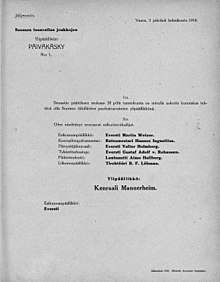
In Stockholm, Mannerheim conferred with Allied diplomats, emphasizing his opposition to the Finnish government's policy: they were confident that the Germans would win the war, and had declared the Kaiser's brother-in-law, Frederick Charles of Hesse, to be the King of Finland. In the meantime P.E. Svinhufvud served as the first Regent of the nascent kingdom. Mannerheim's rapport with the Allies was recognized in October 1918 when the Finnish government sent him to Britain and France to attempt to gain Britain's and the United States's recognition of Finland's independence. In December, he was summoned back to Finland; Frederick Charles had renounced the throne, and in his stead, Mannerheim had been elected Regent. As Regent, Mannerheim often signed official documents using Kustaa, the Finnish form of his Christian name, to emphasize his Finnishness to those who were suspicious of his background in the Russian armed forces, and his difficulties with the Finnish language[41] Mannerheim disliked his last Christian name, Emil, and wrote his signature as C.G. Mannerheim, or simply Mannerheim. Among his relatives and close friends Mannerheim was called Gustaf.[42]
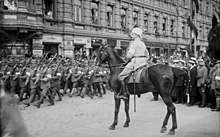
Mannerheim secured recognition of Finnish independence from Britain and the United States. In July 1919, after he had confirmed a new, republican constitution, Mannerheim stood as a candidate in the first presidential election, with parliament as the electors. He was supported by the National Coalition Party and the Swedish People's Party. He finished second to Kaarlo Juho Ståhlberg, and withdrew from public life.[36]
Interwar period
In the interwar years, Mannerheim held no public office. This was largely due to his being seen by many politicians of the centre and left as a controversial figure for his ruthless battle with the Bolsheviks, his supposed desire for Finnish intervention on the side of the Whites during the Russian Civil War, and the Finnish socialists' antipathy toward him. They saw him as the bourgeois "White General". Mannerheim doubted that modern party-based politics would produce principled and high-quality leaders in Finland or elsewhere. In his gloomy opinion, the fatherland's interests were too often sacrificed by the democratic politicians for partisan benefit.[43][44]
He kept busy heading the Finnish Red Cross (Chairman 1919–1951), was a member of the board of the International Red Cross, and founded the Mannerheim League for Child Welfare. He was also the chairman of the supervisory board of a commercial bank, the Liittopankki-Unionsbanken, and after its merger with the Bank of Helsinki, the chairman of the supervisory board of that bank until 1934, and was a member of the board of Nokia Corporation.[45]
In the 1920s and 1930s, Mannerheim returned to Asia, where he traveled and hunted extensively.[46] On his first trip in 1927, to avoid going through the Soviet Union, he traveled through the British Empire, going by ship from London to Calcutta, British India. From there he travelled overland to Burma, where he spent a month at Rangoon; then he went on to Sikkim. He returned home by car and aeroplane.[45]
In his second voyage, in 1936, he went by ship from Aden (a British territory in Arabia) to Bombay. During his travels and hunting expeditions, he visited Madras, Delhi and Nepal, where he was invited by the King to join a tiger hunt.
In 1929, Mannerheim refused the right-wing radicals' plea to become a de facto military dictator, although he did express some support for the right-wing Lapua Movement.[47] After President Pehr Evind Svinhufvud was elected in 1931, he appointed Mannerheim as chairman of Finland's Defence Council and gave him a written promise that in the event of war he would become the Commander-in-Chief of the Finnish Army. (Svinhufvud's successor Kyösti Kallio renewed this promise in 1937). In 1933, Mannerheim received the rank of Field Marshal (sotamarsalkka, fältmarskalk). By this time, Mannerheim had come to be seen by the public, including some former socialists, less as a "White General" and more as a nonpartisan figure, enhanced by his public statements urging reconciliation between the opposing sides in the Civil War and the need to focus on national unity and defence: "we need not ask where a man stood fifteen years ago".[48] Mannerheim supported Finland's military industry and sought in vain to obtain a military defence union with Sweden. However, rearming the Finnish army did not occur as swiftly or as well as he hoped, and he was not enthusiastic about a war. He had many disagreements with various Cabinets, and signed many letters of resignation.[49][50]
Commander-in-Chief

When negotiations with the Soviet Union failed in 1939, Mannerheim withdrew his resignation on 17 October. At age 72, he became commander-in-chief of the Finnish armed forces after the Soviet attack on 30 November. In a letter to his daughter Sophie, he stated, "I had not wanted to undertake the responsibility of commander-in-chief, as my age and my health entitled me, but I had to yield to appeals from the President of the Republic and the government, and now for the fourth time I am at war."[41]
He addressed the first of his often controversial orders of the day to the Defence Forces on the day the war began:
The President of the Republic has appointed me on 30 November 1939 as Commander-in-Chief of the armed forces of the country. Brave soldiers of Finland! I enter on this task at a time when our hereditary enemy is once again attacking our country. Confidence in one's commander is the first condition for success. You know me and I know you and know that everyone in the ranks is ready to do his duty even to death. This war is nothing other than the continuation and final act of our War of Independence. We are fighting for our homes, our faith, and our country.[41]
The defensive field fortifications they manned became known as the Mannerheim Line.
Field Marshal Mannerheim quickly organised his headquarters in Mikkeli. His chief of staff was Lieutenant General Aksel Airo, while his close friend, General Rudolf Walden, was sent as a representative of the headquarters to the cabinet from 3 December 1939 until 27 March 1940, after which he became defence minister.[49][50]
Mannerheim spent most of the Winter War and Continuation War in his Mikkeli headquarters but made many visits to the front. Between the wars, he remained commander-in-chief.[50]
Mannerheim kept relations with Adolf Hitler's government as formal as possible. Before the Continuation War, the Germans offered Mannerheim command over 80,000 German troops in Finland. Mannerheim declined so as to not tie himself and Finland to Nazi war aims.[51] In July 1941 the Finnish Army of Karelia was strengthened by the German 163rd Infantry Division. They retook the Finnish territories annexed by the Soviet Union after the Winter War,[52] and went further occupying East Karelia. Finnish troops didn't take part in the Siege of Leningrad, which lasted 872 days.
Visit by Adolf Hitler

Mannerheim's 75th birthday, 4 June 1942, was a national celebration. The government granted him the unique title of Marshal of Finland (Suomen Marsalkka in Finnish, Marskalk av Finland in Swedish). So far he is the only person to receive the title. A surprise birthday visit by Hitler occurred on the day as he wished to visit the "brave Finns (die tapferen Finnen)" and their leader Mannerheim.[49][50] Mannerheim did not want to meet him at his headquarters or in Helsinki, as then it would seem like an official state visit. The meeting took place near Imatra, in south-eastern Finland, and was arranged in secrecy.[49] From Immola Airfield, Hitler, accompanied by President Ryti, was driven to where Baron Mannerheim was waiting at a railway siding. A speech from Hitler was followed by a birthday meal and negotiations between him and Mannerheim. Overall, Hitler spent about five hours in Finland; he reportedly asked the Finns to step up military operations against the Soviets, but apparently made no specific demands.[49]
During the visit, an engineer of the Finnish broadcasting company YLE, Thor Damen, succeeded in recording the first eleven minutes of Hitler's and Mannerheim's private conversation. This had to be done secretly, as Hitler never allowed off-guard recordings. Damen was assigned to record the official birthday speeches and Mannerheim's response and therefore placed microphones in some of the railway cars. However, Mannerheim and his guests chose to go to a car that did not have a microphone in it. Damen acted quickly, pushing a microphone through one of the car windows onto a net shelf just above where Hitler and Mannerheim were sitting. After eleven minutes of Hitler's and Mannerheim's private conversation, Hitler's SS bodyguards spotted the cords coming out of the window and realized that the Finnish engineer was recording the conversation. They gestured to him to stop recording immediately, and he complied. The SS bodyguards demanded that the tape be destroyed, but YLE was allowed to keep the reel after promising to keep it in a sealed container. It was given to Kustaa Vilkuna, head of the state censors' office, and in 1957 returned to YLE. It was released to the public a few years later. It is the only known recording of Hitler conversing.[53][54]
There is an unsubstantiated story that while conversing with Hitler, Mannerheim lit a cigar. Mannerheim expected that Hitler would ask Finland for more help against the Soviet Union, which Mannerheim was unwilling to give. When Mannerheim lit up, all in attendance gasped, for Hitler's aversion to smoking was well known. Nevertheless, Hitler continued the conversation calmly, with no comment. By this test, Mannerheim could judge if Hitler was speaking from a position of strength or weakness. He refused Hitler, knowing that Hitler was in a weak position, and could not dictate to him.[49][50]
Shortly thereafter, Mannerheim returned the visit, traveling to Hitler's headquarters in East Prussia.[55]
End of war and presidency

In June 1944, Baron Gustaf Mannerheim, to ensure German support while a major Soviet offensive was threatening Finland, thought it necessary to agree to the pact the German Foreign Minister Joachim von Ribbentrop demanded. But even then Mannerheim distanced himself from the pact, and it fell to President Risto Ryti to sign it, so it came to be known as the Ryti-Ribbentrop Agreement. This allowed Mannerheim to revoke the agreement upon the resignation of President Ryti at the start of August 1944. Mannerheim succeeded Ryti as president.[49][56]
When Germany was deemed sufficiently weakened, and the USSR's summer offensive was fought to a standstill (see Battle of Tali-Ihantala) thanks to the June agreement with the Germans, Finland's leaders saw a chance to reach a peace with the Soviet Union.[57] At first, attempts were made to persuade Mannerheim to become prime minister, but he rejected them because of his age and lack of experience running a civil government. The next suggestion was to elect him head of state. Risto Ryti would resign as president, and parliament would appoint Mannerheim as regent. The use of the title regent would have reflected the exceptional circumstances of Mannerheim's election. Mannerheim and Ryti both agreed, and Ryti submitted a notice of resignation on 1 August. The Parliament of Finland passed a special act conferring the presidency on Mannerheim on 4 August 1944. He took the oath of office the same day.[49][56]
A month after Mannerheim took office, the Continuation War was concluded on harsh terms, but ultimately far less harsh than those imposed on the other states bordering the Soviet Union. Finland retained its sovereignty, its parliamentary democracy, and its market economy. Territorial losses were considerable; all Karelia and Petsamo were lost. Numerous Karelian refugees needed to be relocated. The war reparations were very heavy. Finland also had to fight the Lapland War against withdrawing German troops in the north, and at the same time demobilize its own army, making it harder to expel the Germans.[58] It is widely agreed that only Mannerheim could have guided Finland through these difficult times, when the Finnish people had to come to terms with the severe conditions of the armistice, their implementation by a Soviet-dominated Allied Control Commission, and the task of post-war reconstruction.[56]
Before deciding to accept the Soviet demands, Mannerheim wrote a missive directly to Hitler:[59]
Our German brothers-in-arms will forever remain in our hearts. The Germans in Finland were certainly not the representatives of foreign despotism but helpers and brothers-in-arms. But even in such cases foreigners are in difficult positions requiring such tact. I can assure you that during the past years nothing whatsoever happened that could have induced us to consider the German troops intruders or oppressors. I believe that the attitude of the German Army in northern Finland towards the local population and authorities will enter our history as a unique example of a correct and cordial relationship ... I deem it my duty to lead my people out of the war. I cannot and I will not turn the arms which you have so liberally supplied us against Germans. I harbour the hope that you, even if you disapprove of my attitude, will wish and endeavour like myself and all other Finns to terminate our former relations without increasing the gravity of the situation.
Mannerheim's term as president was difficult for him. Although he was elected for a full six-year term, he was 77 years old in 1944 and had accepted the office reluctantly after being urged to do so. The situation was exacerbated by frequent periods of ill-health, the demands of the Allied Control Commission, and the war responsibility trials. He was afraid throughout most of his presidency that the commission would request that he be prosecuted for crimes against peace. This never happened. One of the reasons for this was Stalin's respect for and admiration of the Marshal. Stalin told a Finnish delegation in Moscow in 1947 that the Finns owe much to their old Marshal. Due to Mannerheim, Finland was not occupied.[60] Despite Mannerheim's criticisms of some of the demands of the Control Commission, he worked hard to carry out Finland's armistice obligations. He also emphasised the necessity of further work on reconstruction in Finland after the war.[49][56]
Mannerheim was troubled by recurring health problems during 1945, and was absent on medical leave from his duties as president from November until February 1946. He spent six weeks in Portugal to restore his health. After the announcement of the verdicts in the war crimes trials in February, Mannerheim decided to resign. He believed that he had accomplished the duties he had been elected to carry out: The war was ended, the armistice obligations carried out, and war responsibility trials finished.
Mannerheim resigned as president on 11 March 1946, giving as his reason his declining health and his view that the tasks he had been selected to carry out had been accomplished. Even the Finnish communists, his enemies in 1918, appreciated his efforts and his role in maintaining the unity of the country during a difficult period. He was succeeded as president by the conservative Prime Minister Juho Kusti Paasikivi.[56]
Final days and death

After his resignation, Marshal Baron Mannerheim bought Kirkniemi Manor in Lohja, intending to spend his retirement there. In June 1946, he underwent an operation for a perforated peptic ulcer, and in October of that year he was diagnosed with a duodenal ulcer. In early 1947, it was recommended that he should travel to the Valmont Sanatorium in Montreux, Switzerland, to recuperate and write his memoirs. Valmont was to be Mannerheim's main residence for the remainder of his life, although he regularly returned to Finland, and also visited Sweden, France and Italy.[61]
Because Mannerheim was old and sickly, he personally wrote only certain passages of his memoirs. Some other parts he dictated. The remaining parts were written from his recollections by Mannerheim's various assistants, such as Colonel Aladár Paasonen; General Erik Heinrichs; Generals Grandell, Olenius and Martola; and Colonel Viljanen, a war historian. As long as Mannerheim was able to read, he proofread the typewritten drafts of his memoirs. He was almost totally silent about his private life, and focused instead on Finland's history, especially between 1917 and 1944. When Mannerheim suffered a fatal bowel obstruction in January 1951,[62] his memoirs were not yet in their finished form. They were published after his death.[44]
Mannerheim died on 27 January 1951 (28 January Finland time), in the Cantonal Hospital in Lausanne (French: L'Hôpital cantonal à Lausanne; modern Lausanne University Hospital[63]), Switzerland. He was buried on 4 February 1951 in the Hietaniemi Cemetery in Helsinki in a state funeral with full military honours.
Legacy

Today, Mannerheim retains respect as Finland's greatest statesman. This may be partly due to his refusal to enter partisan politics (although his sympathies were more right-wing than left-wing), his claim always to serve the fatherland without selfish motives, his personal courage in visiting the frontlines, his ability to work diligently into his late seventies, and his foreign political farsightedness in preparing for the Soviet invasion of Finland years before it occurred.[49]
Mannerheim's birthday, 4 June, is celebrated as Flag Day by the Finnish Defence Forces. This decision was made by the Finnish government on the occasion of his 75th birthday in 1942, when he was also granted the title of Marshal of Finland. Flag Day is celebrated with a national parade, and rewards and promotions for members of the defence forces. The life and times of Mannerheim are memorialized in the Mannerheim Museum.[45] The most prominent boulevard in the Finnish capital was renamed Mannerheimintie (Mannerheim Road) in the Marshal's honour during his lifetime.
Various landmarks across Finland honor Mannerheim, including most famously the Equestrian statue located on Helsinki's Mannerheimintie in front of the later-built Kiasma museum of modern art. Turku's Mannerheim Park includes a statue of him. Tampere's Mannerheim statue depicting the victorious Civil War general of the Whites was eventually placed in the forest some kilometres outside the city (in part due to lingering controversy over Mannerheim's Civil War role). Other statues, for examples, were erected in Mikkeli and Lahti.[64] On 5 December 2004, Mannerheim was voted the greatest Finnish person of all time in the Suuret suomalaiset (Great Finns) contest.[2]
From 1937 to 1967, at least five different Finnish postage stamps or stamp series were issued in honour of Mannerheim; and in 1960 the United States honoured Mannerheim as the "Liberator of Finland" with regular first-class envelope domestic and international stamps (at the time four cents and eight cents respectively) as part of its Champions of Liberty series that included other notable figures such as Mahatma Gandhi and Simon Bolivar.[65][66][67]
Military ranks

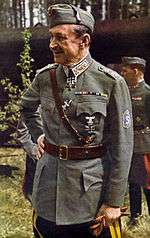
Ranks
In the Russian Army
- 1888: Non-commissioned officer
- 1889: Cornet
- 1891: Cornet of the Guard
- 1893: Lieutenant of the Guard
- 1902: Captain of the Guard
- 1904: Lieutenant Colonel
- 1905: Colonel
- 1911: Major General
- 1917: Lieutenant General
In the Finnish Army
- 1918: General of Cavalry
- 1933: Field Marshal
- 1942: Marshal of Finland
Supreme Command
- 1918: Commander-in-Chief of the White Guard: from January to May 1918
- 1918: Commander-in-Chief of the Finnish Defence Forces: from December 1918 to July 1919
- 1931: Chairman of the Defence Council: from 1931 to 1939
- 1939: Commander-in-Chief of the Finnish Defence Forces [bis]: from 1939 to 1946
Awards
| Coat of Arms of Carl Gustaf Emil Mannerheim | |
|---|---|
 | |
| Armiger | Carl Gustaf Emil Mannerheim |
| Motto | "Candida pro causa ense candido"[68]("With an honourable sword for an honourable cause") |
In the course of his lifetime, Mannerheim received 82 military and civilian decorations.[69]

- Finland




- Russian Empire




- Sweden



- Others



.svg.png)
.svg.png)
.svg.png)





Ancestry
| Ancestors of Carl Gustaf Emil Mannerheim | ||||||||||||||||||||||||||||||||||||||||||||||||||||||||||||||||||||||||||||||||||||||||||||||||||||||||||||||||||||||||||||||||||||||||||||||||||||||||||||||||||||||||||||||||||||||||||||||||||||||||||||||||||||||||||||||||||||||||||||||||||||||||||||||||||||||||||||||||||||||||||||||||||||||||||||||||||||||||||||||||||||||||||||||||||||||||||||||||||||||||||||||||||||||||||||||||||||||||||||||||||||||||||||||||||||||||||||||||||||||||||||||||||||||||||||||||||||||||||||||||||||||||||||||||||||||||||||||||||||||||||||||||||||||||||||||||||||||||||||||||||||||||||||||||||||||||||||||||
|---|---|---|---|---|---|---|---|---|---|---|---|---|---|---|---|---|---|---|---|---|---|---|---|---|---|---|---|---|---|---|---|---|---|---|---|---|---|---|---|---|---|---|---|---|---|---|---|---|---|---|---|---|---|---|---|---|---|---|---|---|---|---|---|---|---|---|---|---|---|---|---|---|---|---|---|---|---|---|---|---|---|---|---|---|---|---|---|---|---|---|---|---|---|---|---|---|---|---|---|---|---|---|---|---|---|---|---|---|---|---|---|---|---|---|---|---|---|---|---|---|---|---|---|---|---|---|---|---|---|---|---|---|---|---|---|---|---|---|---|---|---|---|---|---|---|---|---|---|---|---|---|---|---|---|---|---|---|---|---|---|---|---|---|---|---|---|---|---|---|---|---|---|---|---|---|---|---|---|---|---|---|---|---|---|---|---|---|---|---|---|---|---|---|---|---|---|---|---|---|---|---|---|---|---|---|---|---|---|---|---|---|---|---|---|---|---|---|---|---|---|---|---|---|---|---|---|---|---|---|---|---|---|---|---|---|---|---|---|---|---|---|---|---|---|---|---|---|---|---|---|---|---|---|---|---|---|---|---|---|---|---|---|---|---|---|---|---|---|---|---|---|---|---|---|---|---|---|---|---|---|---|---|---|---|---|---|---|---|---|---|---|---|---|---|---|---|---|---|---|---|---|---|---|---|---|---|---|---|---|---|---|---|---|---|---|---|---|---|---|---|---|---|---|---|---|---|---|---|---|---|---|---|---|---|---|---|---|---|---|---|---|---|---|---|---|---|---|---|---|---|---|---|---|---|---|---|---|---|---|---|---|---|---|---|---|---|---|---|---|---|---|---|---|---|---|---|---|---|---|---|---|---|---|---|---|---|---|---|---|---|---|---|---|---|---|---|---|---|---|---|---|---|---|---|---|---|---|---|---|---|---|---|---|---|---|---|---|---|---|---|---|---|---|---|---|---|---|---|---|---|---|---|---|---|---|---|---|---|---|---|---|---|---|---|---|---|---|---|---|---|---|---|---|---|---|---|---|---|---|---|---|---|---|---|---|---|---|---|---|---|---|---|---|---|---|---|---|---|---|---|---|---|---|---|---|---|---|---|---|---|---|---|---|---|---|---|---|---|---|---|---|---|---|---|---|---|---|---|---|---|---|---|---|---|---|---|---|---|---|---|---|---|---|---|---|---|---|---|---|---|---|---|---|---|---|---|---|---|---|---|---|---|---|---|---|---|---|---|---|---|---|---|---|---|---|---|---|---|---|---|---|---|---|---|---|---|---|---|---|---|---|---|---|---|---|---|---|---|---|---|---|---|---|---|---|---|---|---|---|---|---|---|
| ||||||||||||||||||||||||||||||||||||||||||||||||||||||||||||||||||||||||||||||||||||||||||||||||||||||||||||||||||||||||||||||||||||||||||||||||||||||||||||||||||||||||||||||||||||||||||||||||||||||||||||||||||||||||||||||||||||||||||||||||||||||||||||||||||||||||||||||||||||||||||||||||||||||||||||||||||||||||||||||||||||||||||||||||||||||||||||||||||||||||||||||||||||||||||||||||||||||||||||||||||||||||||||||||||||||||||||||||||||||||||||||||||||||||||||||||||||||||||||||||||||||||||||||||||||||||||||||||||||||||||||||||||||||||||||||||||||||||||||||||||||||||||||||||||||||||||||||||
Works
- C.G. Mannerheim, Across Asia From West to East in 1906–1908. (1969) Anthropological Publications. Oosterhout N.B. – The Netherlands
- Across Asia : Vol. 1 – digital images
Gallery
 Mannerheim's parents: Count Carl Robert Mannerheim and Countess Hélène Mannerheim, 19th century
Mannerheim's parents: Count Carl Robert Mannerheim and Countess Hélène Mannerheim, 19th century Mannerheim siblings. Middle: Sophie Mannerheim; left: Carl, August and Johan; right: Annicka and Carl Gustaf Emil (i.e. Gustaf); sitting: Eva, c. 1880.
Mannerheim siblings. Middle: Sophie Mannerheim; left: Carl, August and Johan; right: Annicka and Carl Gustaf Emil (i.e. Gustaf); sitting: Eva, c. 1880. As a military cadet in 1884
As a military cadet in 1884 On matriculating as a student at the age of 20, in 1887
On matriculating as a student at the age of 20, in 1887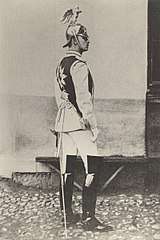 As an officer of the Chevalier Guards in 1892
As an officer of the Chevalier Guards in 1892 Anastasia Mannerheim, his wife from 1892 to 1919
Anastasia Mannerheim, his wife from 1892 to 1919 Daughters Anastasie and Sofia (Sophy)
Daughters Anastasie and Sofia (Sophy) Colonel of the 52nd Nezhin Dragoon Regiment, 1904
Colonel of the 52nd Nezhin Dragoon Regiment, 1904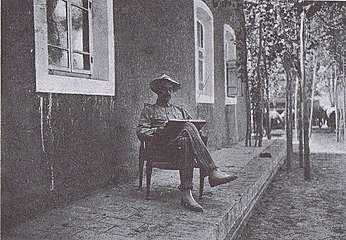 At the Russian Consulate in Kashgar, 1906
At the Russian Consulate in Kashgar, 1906.jpg) Mannerheim on his travels, 1907
Mannerheim on his travels, 1907 Mannerheim at Aksu in 1907
Mannerheim at Aksu in 1907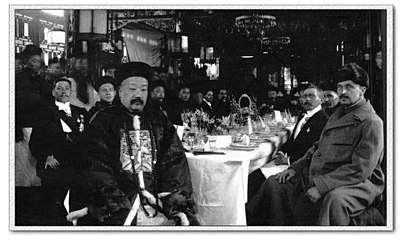
 Commander of 13th Vladimir Uhlan Regiment, 1909–1910
Commander of 13th Vladimir Uhlan Regiment, 1909–1910.jpg) Regent Mannerheim at his official residence in 1919
Regent Mannerheim at his official residence in 1919.jpg) Out of public office, at Runni, Finland in 1920
Out of public office, at Runni, Finland in 1920.jpg) Henrik Ramsay, Mannerheim and Harry Rönngren onboard S/S Ariadne, 1934
Henrik Ramsay, Mannerheim and Harry Rönngren onboard S/S Ariadne, 1934 With his friend, countess Gertrud Wallenberg, cousin of Raoul Wallenberg, at Nice in 1950
With his friend, countess Gertrud Wallenberg, cousin of Raoul Wallenberg, at Nice in 1950 Daughters in 1951
Daughters in 1951
See also
- Hitler and Mannerheim recording
- List of Finnish Wars
- Mannerheim Cross
- Mannerheim Line
- Mannerheim Museum
- Mannerheimintie
- The Marshal of Finland (film)
- Marskin ryyppy
- Vorschmack
Notes
- Klinge, Matti. "Mannerheim, Gustaf (1867–1951)". National Biography of Finland. Retrieved 21 April 2017.
- (in Finnish) Suuret suomalaiset at YLE.fi
- Edwards, Robert, ed. (2007). White Death: Russia's War with Finland 1939–1940. Phoenix. p. 21. ISBN 978-0-7538-2247-0.
- Warner, Oliver (1967) Marshal Mannerheim and the Finns, Weidenfeld & Nicolson. pp. 154 ff.
- Binder, David (16 October 1983). "Finland's Heritage on parade". The New York Times. Retrieved 17 August 2013.
- "Field Marshal Mannerheim, THE FATHER OF FINLAND". 15 November 1945. Retrieved 17 August 2013.
- "Finland Country Profile – Timeline". BBC News. 25 September 2012. Retrieved 17 August 2013.
- "Mannerheimin suku onkin lähtöisin Saksasta". kaleva.fi. 1 March 2007. Archived from the original on 30 September 2007. Retrieved 17 August 2007.
- "Mannerheimin suku onkin lähtöisin Saksasta". mtv3.fi. March 2007.
- Johan Augustin Mannerheim. tjelvar.se (in Swedish)
- Muotokuva; Johan Augustin Mannerheim; (1706–1778). finna.fi (in Finnish)
- Meri (1990), pp. 107–108.
- Meri (1990), p. 108.
- Jägerskiöld (1965), pp. 68–70.
- Jägerskiöld (1965), pp. 93–94.
- Meri (1990), p. 123.
- Jägerskiöld (1986).
- Meri (1990), p. 129.
- Screen (1970), p. 33.
- "Краткие сведения об офицерах-Александрийцах: Великая война, Гражданская война, эмиграция. Часть 2-я (фамилии К – Р). – Статьи – Каталог статей – 5-й Гусарский Александрийский полк". blackhussars.ucoz.ru.
- Meri (1990), pp. 145–147.
- Pallaste, Tuija (4 November 2017). "Mannerheimin tyttärien vaietut elämät: hauras Stasie eli nunnana ja levoton Sophy pakeni Pariisiin – lopulta kumpikin eli suhteessa naisen kanssa". Helsingin Sanomat. Retrieved 12 May 2020.
- Meri (1990), pp. 148–149.
- Trotter (2013), p. 24.
- Clements (2009), p. 40.
- Screen (1970), pp. 43–49.
- Clements (2009), pp. 80–81.
- "Horse That Leaps Through Clouds – Retracing Mannerheim's Journey Across Asia". horsethatleaps.com.
- Caldwell, Christopher (11 August 2017). "Start to Finnish". Washington Examiner. Retrieved 4 February 2020.
It was an 8,000-mile spying expedition. Russia was drawing up plans to invade China from the west—but failed to.
- Clements (2009), pp. 100–103.
- Tamm, Eric Enno (2010). The Horse That Leaps Through Clouds: A Tale of Espionage, the Silk Road and the Rise of Modern China. Vancouver: Douglas & McIntyre. ISBN 978-1-55365-269-4.
- Trotter (2013), p. 29.
- "Horse That Leaps Through Clouds – Retracing Mannerheim's Journey Across Asia". horsethatleaps.com.
- "Horse That Leaps Through Clouds – Retracing Mannerheim's Journey Across Asia". horsethatleaps.com.
- Clements (2009), p. 155.
- Putensen, Dörte (2017). "Der größte Finne aller Zeiten?". Damals (in German). No. 5. pp. 72–76.
- Harald Haarmann (2016). Modern Finland. p. 122.
- Screen (2000), p. 9.
- Mannerheim (1953), p. 138.
- Mannerheim (1953), p. 184.
- Jagerskiold (1986).
- Meri (1990), p. 104.
- Virkkunen, Sakari (1992). Mannerheimin kääntöpuoli. Helsingissä: Otava.
- Jägerskiöld (1983).
- Mannerheim-Museo.fi Archived 13 January 2011 at the Wayback Machine
- Screen (2000), pp. 90–97.
- Screen (2000), p. 104.
- Screen (2000), p. 112.
- Virkkunen, Sakari (1994) "Presidents of Finland II" (Suomen presidentit II), published in Finland
- Turtola (1994).
- Jacobsson (1999).
- Mannerheim (1953), p. 456.
- Helsingin Sanomat International Web-Edition – "Conversation secretly recorded in Finland helped a German actor prepare for Hitler role" Helsingin Sanomat / First published in print 15 September 2004 in Finnish.
- Recording available YLE's web-archive
- Mannerheim (1953), pp. 454–455.
- Zetterberg, Seppo et al., eds. (2003) "A Small Giant of Finnish History" (Suomen historian pikkujättiläinen)
- Screen (2000), p. 205.
- Kinnunen, Tiina; Kivimäki, Ville, eds. (2011). Finland in World War II: History, Memory, Interpretations. p. 87. ISBN 978-9004208940.
- Nenye, Vesa; Munter, Peter; Wirtanen, Toni; Birks, Chris (2016). Finland at War: the Continuation and Lapland Wars 1941–45. Osprey Publishing. ISBN 978-1472815262.
- Meri (1990), p. 397.
- Screen (2000), p. 245.
- Screen (2000), pp. 252.
- "Historique". Centre hospitalier universitaire vaudois. Retrieved 24 February 2018.
- Matti Klinge, transl. Roderick Fletcher. "Mannerheim, Gustaf (1867–1951) President of Finland, Marshal of Finland". Biografiakeskus. Retrieved 12 September 2013.
- "MANNERHEIM – Special Topics – Stamps". www.mannerheim.fi.
- "8-cent Mannerheim". 12 December 2008. Retrieved 18 August 2013.
- "50th Anniversary USA Champions of Liberty Mahatma Gandhi Stamp". 9 March 2011. Retrieved 18 August 2013.
- "Gustaf Mannerheim The Marshal of Finland". mannerheim-museo.fi. Archived from the original on 19 January 2020. Retrieved 2 October 2017.
- Mannerheim Internetprojekti, kunniamerkit valokuvineen (Finnish)
- No. 77, Nousevan Auringon Ritarikunnan I luokka Paulovniakukkasin, Japani, mannerheim.fi.
Bibliography
- Mannerheim, Carl Gustaf Emil (1953). The Memoirs of Marshal Mannerheim. London: Cassell. OCLC 12424452.CS1 maint: ref=harv (link)
- Clements, Jonathan (2009). Mannerheim: President, Soldier, Spy. London: Haus Publishing. ISBN 978-1907822575.CS1 maint: ref=harv (link)
- 1999: Petteri Koskikallio, Asko Lehmuskallio, and Harry Halén. C. G. Mannerheim in Central Asia 1906–1908. Helsinki: National Board of Antiquities. ISBN 951-616-048-4.
- Jacobsson, Max (1999). Century of Violence.CS1 maint: ref=harv (link)
- Jägerskiöld, Stig (1965). Nuori Mannerheim.CS1 maint: ref=harv (link)
- Jägerskiöld, Stig (1983). Mannerheim 1867–1951. Helsinki: Otava Publications.CS1 maint: ref=harv (link)
- Jägerskiöld, Stig (1986). Mannerheim: Marshal of Finland. Minneapolis: University of Minnesota Press. ISBN 0-8166-1527-6.CS1 maint: ref=harv (link)
- Meri, Veijo (1990). Suomen marsalkka C. G. Mannerheim.CS1 maint: ref=harv (link)
- Screen, J. E. O. (1970). Mannerheim: The Years of Preparation. Vancouver: University of British Columbia Press. ISBN 0-900966-22-X.CS1 maint: ref=harv (link)
- Screen, J. E. O. (2000). Mannerheim: The Finnish Years. London: Hurst. ISBN 1-85065-573-1.CS1 maint: ref=harv (link)
- Trotter, William (2000). A Frozen Hell: The Russo-Finnish Winter War of 1939–1940. Chapel Hill: Algonquin Books. ISBN 1-56512-249-6.
- Turtola, Martti (1994). Risto Ryti: A Life for the Fatherland. Risto Ryti: Elämä isänmaan puolesta. Helsinki: Otava.CS1 maint: ref=harv (link)
External links
| Wikimedia Commons has media related to Carl Gustaf Emil Mannerheim. |
- Mannerheim's Journey Across Asia including interactive Google maps, slide shows, videos and more
- C. G. E. Mannerheim in the history of Finland
- Mannerheim Museum
- Audio recordings of Hitler and Mannerheim's public and private talk (w/English text on YouTube), 4 June 1942
- (in Finnish and Swedish) Mannerheim's 1944 inauguration address
- On Mannerheim's role in defending Jews
- Валентин Рянжин. Маршал Финляндии Маннергейм (russian)
- Русский офицер у Далай-ламы (russian)
- Маннергейм – русский генерал, финский маршал (russian)
- Mannerheim League for Child Welfare English website
- Carl Gustaf Emil Mannerheim at Find a Grave
- Newspaper clippings about Carl Gustaf Emil Mannerheim in the 20th Century Press Archives of the ZBW
| Regnal titles | ||
|---|---|---|
| Preceded by Pehr Evind Svinhufvud |
Regent of Finland 1918–1919 |
Succeeded by Kaarlo Juho Ståhlberg as President of the Republic |
| Political offices | ||
| Preceded by Risto Ryti |
President of Finland 1944–1946 |
Succeeded by Juho Kusti Paasikivi |